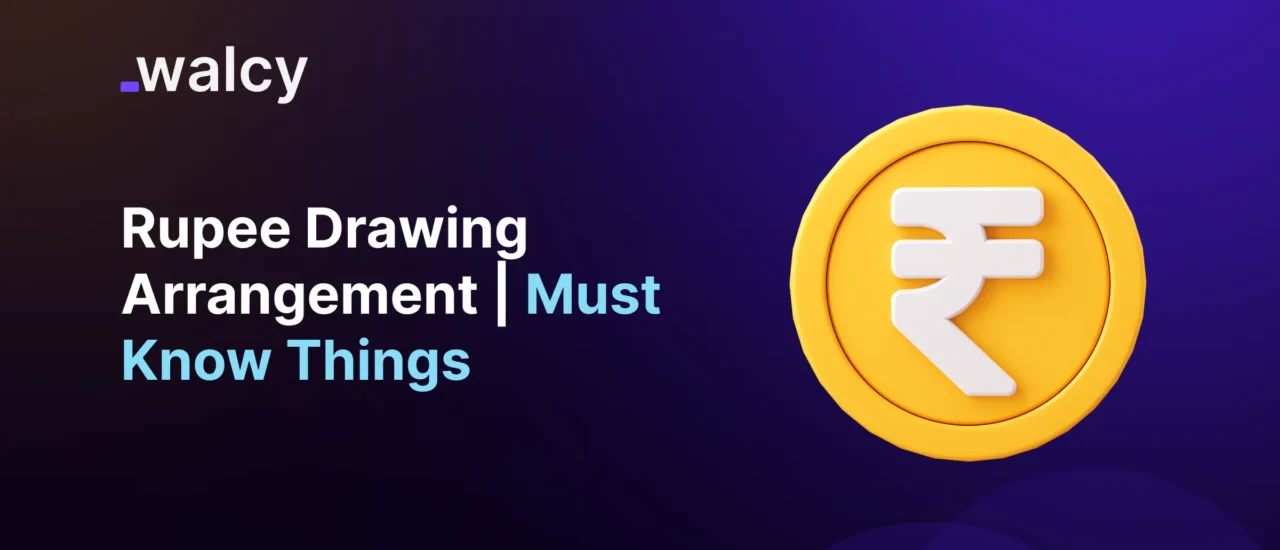Rupee Drawing Arrangement forms an important feature of the foreign exchange mechanism in India. It has been designed for the transfer of funds by Non-Resident Indians or Persons of Indian Origin to India. RDA finds a significant position in the larger economic context. It hence places the arrangement with the Reserve Bank of India, commonly referred to as the RBI, within the regulatory framework to ensure that there is no countering influence in the movement of remittances into the country.
This is a comprehensive guide on various aspects that concern the Rupee Drawing Arrangement: its purpose, importance, limits imposed on remittances, and the benefits it carries. This explanation shows how stakeholders can understand these elements and appreciate more how the RDA contributes to the Indian economy and the individual beneficiaries of this arrangement.
What is the Rupee Drawing Arrangement?
The Rupee Drawing Arrangement is a scheme under which banks in India can have tie-ups with foreign exchange houses, overseas banks, or other entities abroad to facilitate the transfer of funds from NRIs and PIOs to India. Under this arrangement, the foreign exchange houses or banks remit funds to India, which are credited to the account of the beneficiaries in Indian Rupees upon conversion.
RDAs represent an important channel for inward remittances that form a significant part of the country’s foreign exchange reserves. The scheme is usually availed for personal remittances, family maintenance, savings, and all other purposes. It provides an easy and secure way for NRIs to send money to their families in India, thus helping in maintaining economic stability within the country.
Importance of the Rupee Drawing Arrangement
Hence, the Rupee Drawing Arrangement is vital for the Indian economy in several ways:
Foreign exchange reserves:
They increase the foreign exchange reserves of the country, to which the RDA remittances contribute enormously. Such foreign exchange reserves are essential to maintain the country’s financial stability by managing the exchange rate, and ensuring that the external obligations regarding payments fall in place.
Family Support:
For many Indian families, RDA is a lifeline, whereby families have to rely on remittances from kith and kin working abroad. Funds received through this arrangement assist in catering to household expenses, education, health care, and other basic needs.
Economic Growth:
Remittances coming under RDA support consumption and investment in the economy. Generally, these funds are used for buying goods and services, purchasing real estate, or establishing small enterprises, which, in turn, affect economic growth.
Stable Source of Funds:
Unlike FDI or portfolio investment, which may be volatile, RDA-assisted remittances are a more stable source of funds. Stability is a factor of immense importance concerning long-term economic planning and policy formulation.
Increased Financial Inclusion:
RDA brings about financial inclusion by increasing the circle of people coming within the formal banking network. The beneficiaries, upon receipt of their remittances through bank accounts, join the fold of formal banking and are in a position thereafter to access all other banking services.
Read more about: Bank Remittance In 2024 | How It Differs To Bank Transfer?
How does Rupee Drawing Arrangement Work?
The Rupee Drawing Arrangement works under the ambit of the RBI of India, which issues guidelines and lays down rules for the conduct of the scheme. Here’s how this happens in steps:
Tie-up between Banks and Exchange Houses:
Banks in India ink agreements with foreign exchange houses, banks, or other entities abroad who are authorized to do business. It is in these agreements that the terms and conditions for remitting funds to be transferred and converted to Indian Rupees are outlined.
Funds Transfer:
A Fund Transfer is initiated by an NRI or PIO through a Foreign Exchange House or bank abroad. It is affected by the local currency of the host country in which the NRI is Resident.
Conversion and Credit:
The foreign exchange house/bank upon receipt of money remits the amount to its correspondent bank in India. The bank in India receives the foreign currency, converts the same into Indian Rupees, and credits the amount to the beneficiary’s account in India.
Compliance and Reporting:
The entire mechanism is brought under severe compliance with RBI guidelines. The banks and exchange houses have to strictly follow AML and KYC norms to confirm the authenticity of the transaction.
Beneficiary Notification:
At the time of credit receipt, the Indian bank notifies the beneficiary through SMS, email, and/or other communication channels. This maintains transparency and provides tracking abilities to the beneficiaries for their remittances.
You shall love: Top Factors Affecting Foreign Exchange Rates in 2024.
RDA Remittance Limits
While the Rupee Drawing Arrangement does not necessarily have specific quantum limits, there are indeed some limits imposed by the RBI. These limits have been so designed to prohibit money laundering, terrorism financing, and other illicit activities while ensuring proper utilization of the arrangement for its genuine use.
Individual Remittance Limit:
The overall ceiling that RBI normally prescribes is the maximum amount that could be transferred under RDA in a single transaction. It is subject to periodic review and may be varied depending upon the type of remittance, origin of funds, and purpose of transfer.
Annual Cap:
Additionally, there is an annual cap on the overall quantity that can be remitted by an individual through RDA. This cap helps to monitor large or frequent transactions that could indicate suspicious activities.
Permission for Purpose-Based Limits:
The RBI will allow specific limits based on the purpose of remittance. For example, remittances for education or medical treatment could fall under different limits than remittances intended for family maintenance or savings.
Country-Specific Restrictions:
There may be more restrictions under the RDA, depending on the country of origin. Some countries may be considered to have less stringent controls, while geopolitical considerations, AML issues, or even bilateral agreements may make others more restrictive.
These are the limits that NRIs and PIOs have to be aware of to comply with and avoid any legal or financial penalty for noncompliance.
Read more about; International Remittance Business in 2024 | Explained
Benefits of the Rupee Drawing Arrangement
Several benefits accrue to NRIs through the RDA, just as the Indian economy also benefits from this arrangement. Some of these advantages are listed below:
Convenience:
RDA makes it easy for NRIs to remit money to India since there is a large number of participants, including exchange houses and banks, in this arrangement.
Safety:
The transactions under RDA are secured and protected through proper vigil and regulation of RBI. Stringent compliance ensures safety and no fraudulent or misutilization of the transfer amounts.
Competitive Exchange Rates:
Since the funds are converted into Indian Rupees by the receiving bank, NRIs often realize a competitive exchange rate. This ensures that the maximum value of the remittance is retained.
Competitive Transfer Costs:
RDA has a low transfer fee compared to other methods resorted to by NRIs for sending money to India. This is an important consideration for NRIs who make frequent remittances.
Tax Benefits:
In some cases, NRIs may be granted exemptions in the tax payment for the amount transferred via RDA. For example, the amounts that are being used for specific purposes like education or medical treatment may get an exemption from tax.
Financial Inclusion:
RDA facilitates financial inclusion by increasing the usage of formal banking channels. It enhances the financial services provided to the beneficiaries and increases the financial literacy of the population as a whole.
Economic Contribution:
The inflow of foreign currency is facilitated through the mechanism of RDA, adding to the growth of the economy in India. Funds are generally utilized for consumption, investment, and savings, thereby accelerating economic activities and giving a fillip to economic development.
Read about: The Impact of Exchange Rates on the Global Economy
Challenges and Considerations
While the Rupee Drawing Arrangement has many advantages, it equally presents certain challenges that are to be taken into consideration, and these include:
Onus of Compliance:
The requirement for strict adherence to AML and KYC norms, among other stringent compliance requirements, is quite cumbersome for banks and remitters. Ensuring that these requirements are duly met would be time-consuming and may discourage NRIs from using the RDA.
Volatility of Exchange Rate:
While the RDA generally gives the best exchange rates, and may try hedging against the fluctuation in values in the case of frequent trades, it impacts the final remittance that the beneficiary gets. NRIs must keep this in consideration while planning their remittances.
Awareness and Access:
Not all NRIs might be aware of the RDA arrangement or have easy access to the participating exchange houses/banks in the arrangement. More awareness and accessibility of RDA services will maximize its fullest benefits.
Geopolitical Risks:
RDA is always at the mercy of geopolitical risks, particularly if the political or economic environment in that region is not stable. Some such NRIs face issues in remitting funds, or worse, may be placed under greater-than-normal restrictions.
Technological Challenges:
While digital platforms have been a milestone in facilitating fund transfers across the world today, some NRIs, especially senior citizens, cannot grasp how to use online services. Ensuring ease of use and facilitating customer support will help address this issue.
Read about: What Are The Penalties For Money Laundering? Quick Facts
Conclusion
Rupee Drawing Arrangement constitutes one of the lifelines of the foreign exchange ecosystem in India by acting as a facilitator for the seamless transmission of remittances sent by NRIs and PIOs to their families/loved ones in India. RDA contributes much toward foreign exchange reserves, economic growth through this receipt, and financial inclusion and hence to the overall economic stability of the country.
While this is so, the complete advantages of an RDA would accrue only if banks and remitters are aware of its limits, compliance requirements, and possible challenges. Only such steps can ensure that the RDA remains a durable and proper channel for remittances, serving not only the immediate interests of the individuals concerned but also the larger objective of being gainful to the Indian economy.
You shall love to read about: All About Overseas Payments (2024); Comprehensive Guide



